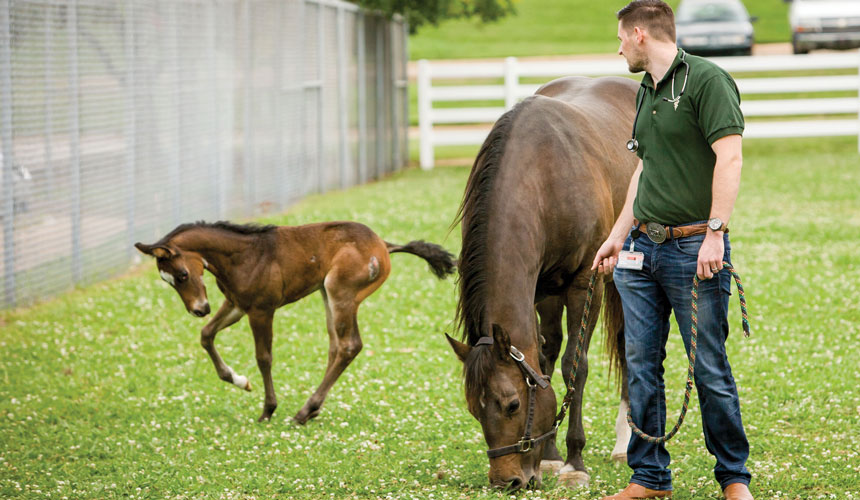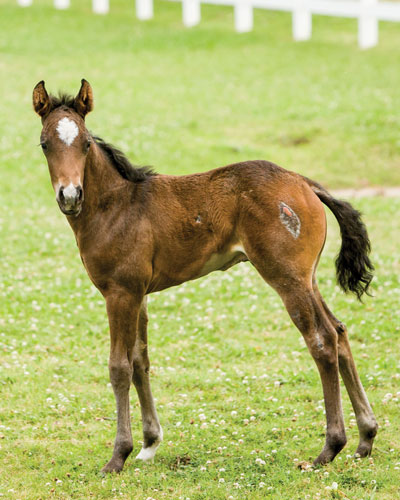A Big Win for a Tiny Colt
Friday, January 27, 2017
JJ overcomes serious obstacles with OSU’s help

Premature birth.
Underdeveloped bones.
Pneumonia.
And more.
Any one of those problems would be a challenge for a colt. Poor JJ, born in April, had to overcome them all.
Dharma’s colt weighed only 50 pounds at his birth in Newkirk, Okla. Within his first 12 hours, owner Karen Smith had rushed him to Oklahoma State University’s Veterinary Medical Hospital.
“When he arrived in the hospital’s Gaylord Neonatal Care Wing, he was able to stand but had severe tendon laxity of all four limbs and suffered from partial failure of passive transfer due to inadequate colostrum intake,” says Dr. Jenna Young, equine intern on the case. “Nursing within the fi few hours of birth is vital to the health of any foal, much less a premature one.”

Foals rely on their mother’s antibody-rich milk or colostrum for protection from disease. Without it, the foal developed pneumonia. But that wasn’t his only problem.
“He was born with incomplete ossification of his carpal and tarsal bones,” says Young. “He was at risk of crushing his underdeveloped bones and developing severe lameness and arthritis long-term if he were allowed to walk on them.”
OSU’s team placed a tube cast on each leg to ensure proper alignment of his bones. He then had to lie in a bed, standing solely for feedings. Weekly radiographs monitored his progress. The foal was in casts for 3½ weeks with round-the clock care to ensure he remained down and to help him change his position frequently.
Smith decided to name the colt after one of the students assigned to his case — Jeff Henderson. According to Henderson, the colt would follow him everywhere. OSU faculty and staff started calling the colt JJ for Jeff Junior.
“A little under one month after JJ was born, his bones had developed enough that we were able to take the casts off his legs,” says Young. “It was great to be able to see him standing on his own and interact with his mother as a normal foal again.”
JJ got to go out to the paddock and stretch his legs for short periods of time initially.
Unfortunately in the meantime, JJ developed an abscess in his umbilicus that had to
be removed. Luckily, he bounced back from this surgery in no time.
There was one more hurdle to overcome.
“JJ has been fed out of a pan or bucket since he arrived. Soon aft his casts came
off, we began trying to encourage him to nurse from his mother,” says Young.
“Shortly thereafter, he latched on to Dharma for the first time and never looked back
to his milk bucket again!”
JJ went home on May 31, aft more than six weeks in the hospital.
A recheck 10 days later showed he had developed an angular limb deformity of his right hind hock. JJ underwent surgery to place a screw across his growth plate to retard growth on the overgrown side.
“We’ve had our registered quarter horses at OSU’s Veterinary Medical Hospital before, and we’ve used the breeding services at OSU’s ranch west of Stillwater,” says Smith.“JJ is doing great. He’ll be back one more time to have a screw removed from his back right hock. They put it in there to even out his growth. OSU took super care of him. The kids even slept with him while his casts were on to make sure he was okay.”
“It’s very rewarding to see him go from a premature 50-pound little colt who could barely walk to a strong 150-pound guy who can buck, kick, bite, and play as good as the rest of them,” says Young.
The Gaylord Center for Excellence in Equine Health includes the Gaylord Neonatal Care Wing. The wing has three enlarged stalls with swinging half-Dutch doors to accommodate mares and foals. Critically ill foals can be managed in the adjacent partitioned stall region, which allows separate access for veterinary medical staff while mom looks over the half-door.
To support the Gaylord Center for Excellence in Equine Health contact Heidi Griswold at hgriswold@osugiving.com or 405-385-5656.
Watch a video at okla.st/2dENBxq.
Fourth year veterinary student James Riggione holds Dharma while her foal stretches his legs.
“It’s very rewarding to see him go from a premature 50-pound little colt who could barely walk to a strong 150-pound guy who can buck, kick, bite, and play as good as the rest of them.” — Dr. Jenna Young
Gary Lawson / University Marketing
